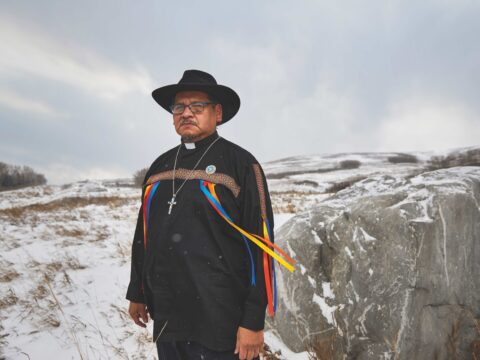CW: This story discusses sexual abuse.
The Meeting House, one of Canada’s largest churches, sent shockwaves in March 2022 when it announced the resignation of its celebrity pastor, Bruxy Cavey, after an independent investigation. The church’s board said it was because Cavey had committed sexual misconduct, but the anonymous person who first made the allegations saw it as something far more.
You may unsubscribe from any of our newsletters at any time.
“This began during a pastoral counseling relationship,” she wrote in a statement in March under the name Hagar, noting it started in 2011 when she was just 23 and Cavey was 46. “I was in crisis and trusted him, and I did not, nor could I, consent to a sexual relationship with him… It was a devastating twisting of pastoral care into sexual abuse.”
For Hagar, this was a clear case of clergy sexual abuse — and she wanted the 5,000-member, multi-site church to name it as such. Initially, Meeting House leaders were reluctant but eventually changed their terminology following discussions with experts and as more allegations came in.
“We heard stories of brave individuals who tried to address the culture of immorality in the past,” said Jennifer Hryniw, a Meeting House board member at a town hall in June 2022. “We are deeply sorry for the abuse and harm that has occurred… We are deeply sorry for how many of these stories have been handled in the past.”
To date, the church has received 38 reports of sexual abuse involving four former staff, including Cavey. In June, police laid charges against Cavey, who has not publicly commented since writing a blog post titled “My Confession,” in which he admits to an “adulterous relationship.”
Clergy sexual abuse is not new, but denominations and churches — like Hillsong, the Southern Baptist Convention and now Be in Christ’s The Meeting House — have only recently begun to admit it takes place and openly deal with it. According to the Mennonite Central Committee’s (MCC) Abuse Response and Prevention program, clergy sexual abuse “is any type of unwanted sexual contact where the victim is violated repeatedly by a person who they should be able to trust” and can be perpetrated by pastors, lay leaders, camp staff and volunteer leadership. The program explains that this form of abuse “is always at its core an abuse of power.”
With stories about clergy abuse making headlines time and again, some churches may wonder: how can we prevent these incidents from occurring in the first place? Experts, including the people behind MCC’s program, have been studying this issue for decades and have recommendations to help congregations avoid certain pitfalls.
1. Establish a culture of democracy
One of the most important elements in creating a positive church culture is how clergy wield authority. “In a church, a pastor has a lot of power and members have little power,” says Scot McKnight, professor at Northern Seminary, which is near Chicago, and author of A Church Called Tov.
Pastors get their power not only by virtue of their position, but also through how members view them. If a church puts a pastor on a pedestal, considering her or him as a star or integral to the survival of the church, then there is a problem. Congregations may let leaders get away with inappropriate behaviour, for example, because they can’t believe their beloved pastor would do anything wrong. They may also dismiss misconduct for fear of the church falling apart if the pastor has to step down.
A good church culture promotes wholeness, healing and health — or tov (the Hebrew word for goodness), explains McKnight. The building blocks include compassion, empathy, service and love, along with accountability and good policies to help govern leadership behaviour.
“[Victims who come forward] are doing [the church] a service by exposing the abuse and helping to prevent it from happening to others.”
One way to do this, according to McKnight, is to focus more on the character of leaders and not so much on congregation size. By emphasizing growth, churches “attract people who can bring numbers, rather than measuring Christlikeness,” he says. “This has created cultures where we are looking for the wrong thing, measuring the wrong thing, and it is an endless cycle of abuse and power and narcissism finding its way to the top in churches.”
Cathy Driscoll is a professor at Saint Mary’s University in Halifax whose research includes spiritual and religious values in ethical decision making. In addition to committing themselves to cardinal virtues such as justice and fortitude, along with a theological emphasis on faith, hope and charity, she believes churches should adopt a victim-focused and trauma-informed approach to abuse. This could counter and transform a church culture of “denialism, complicity, conformity and protectionism when it comes to abuse,” she says.
2. Train clergy to understand their power
Driscoll also cautions against giving pastors too much power. “In many cases, it’s the same thing,” she says, citing alleged misconduct by Cavey, Jean Vanier, Hillsong’s Brian Houston or Sakyong Mipham Rinpoche, the Halifax-based Buddhist leader accused of making inappropriate sexual advances towards two students. “When people have power, they can manipulate others and cover things up.”
Training can be key in helping clergy understand their power — whether they think they have it or not — and the importance of respecting boundaries. “There is a lack of training for pastors about power and boundaries,” says Jaymie Friesen of the MCC’s Abuse Response and Prevention Program in Manitoba, adding “seminaries don’t seem to teach about that.” (MCC and other denominations, including the Anglican and United Church of Canada, offer guidelines and resources for clergy and congregations.)
One danger area for Friesen is counselling, as she believes clergy can easily get in over their heads. She’d like pastors to stop counselling altogether until seminaries provide better training. “Therapists are taught not to cross sexual boundaries,” Friesen explains, “but pastors don’t get training in this. Misconduct can often start in the context of counselling sessions.”
3. Conduct congregational training
Making sure churches are safe spaces for all requires full participation by everyone in the church, says Melodie Bissell, president of Plan to Protect, which helps church-related organizations prevent abuse. She explains that this includes knowing how to recognize “grooming behaviour,” when clergy are crossing lines, and establishing a culture of transparency to hold people accountable for their actions.
Various denominations offer resources for congregations. Such training can also help prepare churches to support the victim if a case of clergy abuse occurs. Too often, members can turn against victims who report abuse. This happened at The Meeting House when someone calling themselves “Anonymous” set up a fake Facebook page and posted videos revealing Hagar’s identity and accusing her of making everything up.
Carol Penner, a professor of practical theology at Conrad Grebel University College in Waterloo, Ont., understands people can be upset when an allegation is made. “The church feels victimized, too. They can begin to put their needs ahead of the victims of abuse, sometimes even blaming the victim or ostracizing them.” But victims who come forward “are actually helping the church,” she says. “They are doing it a service by exposing the abuse and helping to prevent it from happening to others.”
4. Develop sexual misconduct policies and guidelines
Having an appropriate process for victims to report abuse makes it harder for leadership to ignore congregants who come forward with concerns. Well-articulated protocols and policies also help congregations make difficult decisions about how to deal with a pastor who is accused of abuse. “Churches are among the last places to get good policies on sexual misconduct — they didn’t think they needed them,” says Penner, who is helping the MCC rewrite their sexual misconduct guidelines.
More on Broadview:
- United Church of Canada sued over alleged abuse in maternity homes
- Why the apologies from these pastors fall flat
- Why pastors should not be counselling their parishioners
If abuse happens, “victims need a safe place to go tell their stories,” she adds, noting many churches impose a culture of silence in order to try to protect their reputation or not harm their Christian witness. What makes it worse is the use of religious language such as sin, the devil or moral failure as causing the abuse and downplaying the criminal nature of such actions. “They might say, ‘Look at Paul, he killed someone and was forgiven,’” Penner says. “That just lets people go abuse again.”
Whenever a church has a case of clergy sexual misconduct, leaders need to realize people inside and outside the church will be watching how they deal with it. But by covering it up, or not taking it seriously, churches are telling people — including many who have been abused — that their experiences don’t matter.
5. Include women in leadership positions
Another way to tackle the issue of abuse is for churches to have more female clergy and leaders. Not only because victims may feel more comfortable going to another woman to disclose abuse, but because “abuse response and prevention is almost always championed by women,” says Jaymie Friesen of the MCC. Women also tend to be more sympathetic to complaints, she adds, pointing out that almost all women “have experienced boundary violations. They get it.”
Statistics indicate that some denominations have a long way to go to achieving gender equity in the pulpit. On the one hand, the Anglican Church of Canada had nearly 36 percent female clergy in 2016 and the United Church had about 41 percent in 2018. Then there’s the Christian Reformed Church, where women made up less than 17 percent of active ministers in 2021. The Catholic Church, meanwhile, doesn’t have any female priests recognized by the Vatican.
Until parity is reached, ministers and leaders can make churches feel safer for women by the language they use in services. “This includes not only using the father image for God,” explains Val Hiebert, who works with Friesen in the MCC’s abuse prevention program. “It can lead people to conclude that if God is male, then male is God, something that reinforces patriarchy and grants power to males. There are lots of other images in the Bible for God.”
***
John Longhurst is a writer based in Winnipeg.














Noting wrong with the article BUT
It focuses on sexual abuse by a clergy; a popular issuae today..
It fails to touch on underlying basic abuse of a Pastor by an anti body within the church, This failure is far more fundamental.
I visited a church who have the finest statement of Faith that I have ever read But 5 key leaders had just resigned and an assisting minister was being transferred to another church “for his own good”
Regional council was NOT involved in this obvious abuse by one side or the other of both their Pastor & an assistant. What hope is there of accomplishing any healthy solution when a fine Faith Statement involving relationships, a Regional Council; a solution common in many organizations, move them to another location,
are inactive and/or ignored, what hope is there for positive leadership & healing in a specific case. What hope when the very message of the church of love & healing is clearly called BS in our failure.